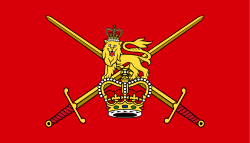| Royal Logistic Corps | |
|---|---|
 Insignia and cap badge of the Royal Logistic Corps | |
| Active | 5 April 1993 – present |
| Country | |
| Branch | |
| Role | Military logistics |
| Garrison/HQ | Worthy Down Camp, Winchester |
| Motto | "We Sustain" |
| March | On Parade Lion, Sword and Crown |
| Commanders | |
| Colonel-in-Chief | Anne, Princess Royal |
| Corps Colonel | Colonel Jacqueline Powell ADC |
| Master General of Logistics | Major General Jo Chestnutt CBE |
| Command Sergeant Major | Warrant Officer Class 1 (Corps SM) Wayne E Marquis |
| Insignia | |
| Tactical recognition flash |  |
The Royal Logistic Corps provides logistic support functions to the British Army. It is the largest Corps in the Army. [1]

